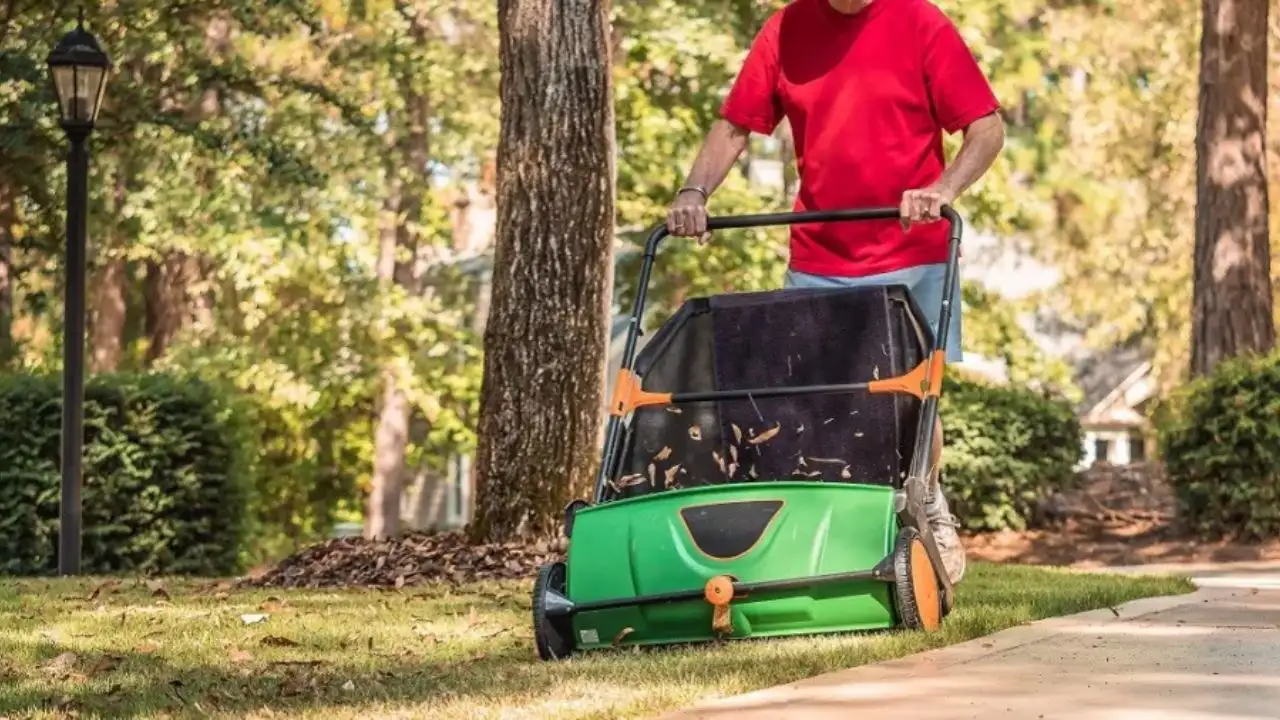In this post, let Garden Nurturer explore these two popular yard maintenance tools, weigh their pros and cons, and offer insights to help you make an informed decision.
We will first delineate each device to facilitate understanding, elucidating its functionality and general characteristics. Subsequently, we will delve into a more detailed discussion on certain aspects that we consider significant importance.
Find out more about leaf blowers and lawn sweepers
Leaf Blower
- Benefits of Using a Leaf Blower
Leaf blowers are powerful tools designed for versatility and efficiency in clearing leaves and light debris from your yard. They are handy for large areas and around obstacles where raking would be cumbersome.
- Types of Leaf Blowers and Their Features
Leaf blowers come in various forms – handheld, backpack, and walk-behind models, each suited to different requirements. Handheld and backpack blowers are perfect for domestic use, providing mobility and convenience, while walk-behind models offer power suited for more extensive or commercial spaces.
- Best Practices for Using a Leaf Blower
Using a leaf blower effectively requires technique and consideration for your surroundings. It’s best to use them on dry days, and starting from one corner of your yard and working your way methodically ensures efficient coverage. Additionally, be mindful of noise levels and local regulations concerning leaf blower use.

Lawn Sweeper
- Benefits of Using a Lawn Sweeper
Lawn sweepers are a quiet and environmentally friendly alternative to leaf blowers. They mechanically pick up leaves and debris as you push them across your lawn, making them excellent for those who prefer a more physical but less disruptive approach to garden cleaning.
- Types of Lawn Sweepers and Their Features
Like leaf blowers, lawn sweepers come in various designs, including push and tow-behind models. Push lawn sweepers are similar to manual lawnmowers and are great for smaller yards. Tow-behind models attach to a tractor or riding mower and are catered to larger areas.
- Best Practices for Using a Lawn Sweeper
Regularly empty the collection bag and adjust the height to match your lawn’s condition for optimal results with a lawn sweeper. Regular maintenance of the brushes will guarantee efficient pickup and longevity of the equipment.

Factors to consider before choosing a leaf blower or lawn sweeper
When selecting the ideal tool for garden maintenance, whether a leaf blower or a lawn sweeper, it’s crucial to consider several nuanced factors:
Dimensions and Configuration of Your Garden
The size and layout of your yard play a pivotal role in the choice of tool. A pull-behind lawn sweeper or a robust leaf blower might be more effective for expansive and open spaces. Smaller, more intricate garden layouts could benefit from the precision and ease of use a handheld blower offers.
Variety of Garden Debris
It’s essential to evaluate the kinds of materials you’ll be gathering. Lawn sweepers excel in picking up larger debris like twigs and leaves. On the other hand, leaf blowers offer versatility, effectively handling a broader range of debris, including smaller leaves, dust, and even light snow.
User Comfort and Physical Considerations
Your physical capabilities and comfort level are crucial in this decision. If manual labor is a concern, a powered leaf blower might be more suitable, reducing physical exertion. For those who prefer a more gentle, noise-free garden experience, a lawn sweeper, which operates quietly and smoothly, could be the better choice.

Time Investment for Garden Maintenance
Reflect on how much time you’re willing to dedicate to yard upkeep. A leaf blower can swiftly clear an area, making it ideal for quick, efficient cleanups. In contrast, while thorough, lawn sweepers might require more time to cover the exact location.
Environmentally-Friendly Options
The choice between electric, battery-powered, or manual tools can be significant for eco-conscious gardeners. Electric or battery-powered blowers are less noisy and emit fewer pollutants than gas-powered ones, while manual lawn sweepers are the most environmentally friendly, producing no emissions.
Storage and Maintenance Requirements
Consider the storage space available and your willingness to perform tool maintenance. Larger, pull-behind sweepers need more storage space and may require regular maintenance, whereas handheld blowers are typically easier to store and maintain.
Comparison and Decision-making
Pros and cons of leaf blowers and lawn sweepers
Leaf Blowers:
- Pros: Fast, efficient, and can handle different debris types.
- Cons: Noisy, can be heavy, may require fuel.
Lawn Sweepers:
- Pros: Quieter, easy to use, gently collects debris.
- Cons: Less versatile, primarily for leaves and grass clippings.

Factors to consider when choosing between the two
- Match the tool to the job’s demands.
- Understand your capabilities and preferences.
- Weigh the convenience against ecological considerations (noise and emissions).
Making an informed decision based on your needs and requirements
Ultimately, your decision will come down to personal needs and yard conditions. If you value speed and versatility and don’t mind a bit of noise and maintenance, a leaf blower could be the way to go.
However, a lawn sweeper may be your best bet if you prefer a quieter, more leisurely pace of work or have a smaller area to manage.
Conclusion
In short, leaf blowers and lawn sweepers have a role to play in yard maintenance. Leaf blowers help clear debris quickly and without much effort, while lawn sweepers offer a gentler, albeit slightly more time-consuming, alternative.
Evaluate your yard’s needs based on the functions and features of each tool and choose what works best for your situation – this is key to maintaining a beautiful outdoor space.
The article shared by Garden Nurturer will help you choose the suitable machine for your needs.






